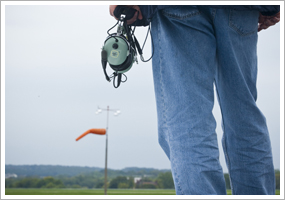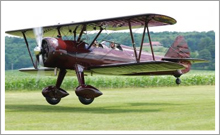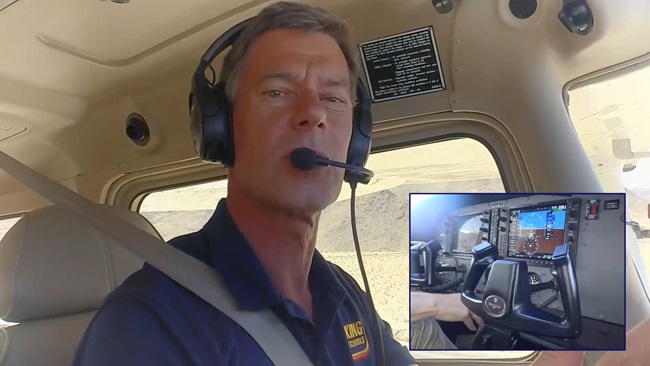| ||||
| | FT News | INSIDE AOPA | TRAINING PRODUCTS | FINAL EXAM | |||
TRAINING TIPsGone with the wind
Spare yourself the trouble! The simple truth is that all the prep in the world doesn’t predict everything that can happen. Experience breeds skepticism. Fortunately, that learning process starts with your first weather briefing.
One of the most common examples of feeling betrayed by the forecast is encountering surface winds that differ markedly from what was predicted. You soon learn that winds can change so quickly that even the wind speed and direction you get by radio when inbound for landing may not be what’s there when you arrive. In the July 2010 Flight Training story “ Phantom wind," one pilot recounted how that made a crosswind landing unnecessarily difficult. “The obvious had escaped me. The AWOS was wrong, or the conditions changed. There was no crosswind, and the airplane was clearly telling me so. With that detail, I landed easily,” wrote Joe Wilbur of the day’s unexpected lesson. Yes—of course you still should check the surface conditions being broadcast for your arrival. But how does one avoid the trap Wilbur describes? The Jan. 7, 2005, “ Training Tip: Check the sock” offers this tip: “When planning your arrival based on an ATIS broadcast, note the time it was prepared, stated at the beginning of the report.” Variable wind speed and direction are also clues.
All the more reason to heed the call by AOPA Air Safety Foundation President Bruce Landsberg to stay informed while helping others do likewise. “It is as important to report something that isn't there as what is. No turbulence, no ice, good visibility, etc. will help all of us make better decisions. If the forecast calls for bad weather and we can verify that it's safe to fly, that information should be widely distributed. When it is as bad or worse than forecast, it is vital for other pilots to know that the NWS nailed it,” he wrote in the safety article “ A trip not taken.” YOUR PARTNER IN TRAININGMaybe you’re transitioning to a new aircraft and you want the basics. Or perhaps you’re interested in a bit of history on your own trainer, or even an airplane you’re thinking of buying. If so, check out AOPA’s Aircraft Fact Sheets. The fact sheets are quick snapshots of the basics of the most popular general aviation aircraft in the fleet. Check it out today to learn more about the airplane you’re interested in.
Did you know that student pilots who join AOPA are three times more likely to complete their flight training? Membership includes unlimited access to aviation information by phone (800/USA-AOPA, weekdays from 8:30 a.m. to 6 p.m. Eastern time) or from AOPA Flight Training Online or AOPA Online. If you're not already a member, join today and get the pilot's edge. Login information is available online. FLIGHT TRAINING NEWSScott Crossfield teacher award namedLt. Col. Bill Powley, a retired Air Force officer and mentor to thousands of Air Force Junior ROTC cadets, is the winner of the twenty-fourth annual A. Scott Crossfield Aerospace Education Teacher of the Year Award. The award was announced by the National Aviation Hall of Fame in Dayton, Ohio. Powley, a 1967 graduate of the U.S. Air Force Academy, has flown supersonic fighters, 347 combat missions, and is twice a recipient of the Distinguished Flying Cross. Read more >> Cessna awards flight training scholarshipsCessna has awarded two flight training scholarships in support of International Learn to Fly Day. Salvador Valdes of Los Angeles, Calif., won a $10,000 flight training scholarship that she will use at Vista Air, a Cessna Pilot Center in Pacoima, Calif. Valdes is an engineering student at the University of California-Los Angeles. Valeri Simmons of Olathe, Kan., received a $5,000 training credit that she will use at Air Associates of Kansas, a Cessna Pilot Center in Olathe. Simmons flew with her father as a young girl, and her son is learning to fly as well. Kansas State awarding scholarships at OshkoshKansas State University in Salina, Kan., will hold seven daily drawings for $2,000 scholarships—one on each day of EAA AirVenture in Oshkosh, Wis., July 26 through Aug. 1. Recipients must be a high-school junior or senior during the 2010-2011 academic year, be a transfer student, or start earning a bachelor’s degree at Kansas State’s Salina campus within the next two years. The university’s aviation program offers degrees in professional piloting, aircraft maintenance, technology management, and engineering technology, as well as air traffic control, airport management, avionics maintenance technology, and unmanned aerial systems. Read more >> School briefs• Eastern Michigan University’s aviation program was recently granted FAA Part 141 approval. According to the school, this means students can save up to $15,000 off the cost of training and compress the training time. • Pennsylvania Highlands Community College will begin offering a flight training class in the fall with partner MTT Aviation Services. Inside AOPADon’t be afraid of the darkOnce the sun has set and the night sky reigns, you’re in for a mostly magical and peaceful time aloft. The air is usually smoother, and the view can be breathtaking over well-lit terrain. But night flying has its challenges, and they call for additional planning and skills. That’s why you want to take the AOPA Air Safety Foundation’s new Night Operations quiz, underwritten by the AOPA Insurance Agency. Quick: How many minutes before night flight should you avoid bright light sources? Do regulations require you have an electric landing light for your rental aircraft? Take the quiz >> Do the right thingDuring flight training you hear a great deal about aeronautical decision making (ADM) and the importance of that concept in flight safety. The AOPA Air Safety Foundation takes ADM to a higher level with Do the Right Thing: Aeronautical Decision Making for Pilots. This interactive online course offers a helpful way of understanding a complex process—no psychology degree required. Listen up and pay attention to how you make decisions on your next flight—because what really matters is how you apply what you have learned. Take the course. This course qualifies for AOPA Accident Forgiveness and the FAA Wings Program. Don’t wait to learn and apply new skills. Be prepared in case of accident or incidentAOPA Counsel Kathy Yodice wants AOPA members to remember that even the most judicious pilots can have an accident or incident involving their airplane. “It’s not that unusual to have a ground mishap—a hard landing, a taxi incident, a mechanic drops a tool, hangar rash. Or, your aircraft can have a mechanical malfunction. These may have little or nothing to do with the member’s skill in operation of an aircraft. Still, they could fall under the category of accidents triggering legal obligations to report the matter to the proper authorities,” she says. Read more >> Buying a friend’s airplane made easy by AOPAWhen a friend of Dave Ohser put his airplane up for sale, Ohser was not in the market to buy an airplane. But when the friend insisted that Ohser buy his airplane, he said yes but cautioned that he didn’t think he would be able to get financing for it. It wasn’t that Ohser had bad credit—he had no credit history. Based on a preference for paying cash, Ohser did not believe he could get the loan. But he went to AOPA Online, filled out the aircraft financing form, and pressed “submit.” Within 24 hours, he was approved for the loan. Read more >> TRAINING PRODUCTSDRE Communications DRE-1001Students looking for a low-cost headset have another option with DRE Communication’s newly upgraded DRE-1001. The company is known for producing quality, reasonably priced models, and the new DRE-1001 fits that mold. It features mil-spec parts, gel ears seals, and a steel headband for only $130.95.
Note: Products listed have not been evaluated by ePilot editors unless otherwise noted. AOPA assumes no responsibility for products or services listed or for claims or actions by manufacturers or vendors. FINAL EXAMQuestion: What kind of information can you gather by observing the windsock at an airport?
Answer: The windsock, or the “wind cone” as the FAA calls it, is a good source of information for a pilot. It not only indicates wind direction, but also allows the pilot to estimate wind velocity and gusts. According to FAA Advisory Circular 150/5345-27D “ Specification for wind cone assemblies,” a windsock will take the form of a truncated cone when filled with air. It must move freely and indicate the wind direction within 5 degrees in a 3-knot wind. The advisory circular also specifies that the cone will be fully extended in a wind of 15 knots. So, you may estimate that a limp windsock indicates a no-wind condition. A windsock extended at 45 degrees may indicate a wind of around 7 knots, and when the windsock is fully extended, the winds may be 15 knots or greater. Windsocks will tend to move back and forth when the wind is gusty. They point downwind, so when you land or take off, you will be flying from the smaller end of the cone toward the larger. For more information on windsocks or other wind indicators, take a look at “ Which way is the wind blowing?” in Flight Training magazine.
Got a question for our technical services staff? E-mail [email protected] or call the Pilot Information Center, 800/872-2672. Don’t forget the online archive of “Final Exam” questions and answers, searchable by keyword or topic. what’s new onlineDeveloping a networkHaving a solid network of experienced and knowledgeable people is vital if you’re just starting out in training, or looking for that dream flight job. This week in the Flight Training blog we explore the basics of this important skill. Read more >> aopa career opportunitiesEver dream of turning your passion for aviation into a career? We're looking for a corporate pilot. To learn more about this and other career opportunities, visit AOPA Online. Picture Perfect
AVIATION EVENTS & WEATHER To include an event or to search all events in the calendar, visit AOPA Online. For airport details, including FBO fuel prices, see AOPA Airports. Flight Instructor Refresher ClinicsThe next AOPA Air Safety Foundation Flight Instructor Refresher Clinics are scheduled in Atlanta, Ga., and Fort Worth, Texas, Aug. 7 and 8; Champaign, Ill., Aug. 14 and 15; Costa Mesa, Calif., and Reno, Nev., Aug. 21 and 22; Allentown, Pa., Aug. 28 and 29. For a complete schedule, see AOPA Online.
Can’t make it in person? Sign up for the CFI Refresher Online. AOPA Air Safety Foundation Safety SeminarsAOPA Air Safety Foundation Safety Seminars are scheduled in Oshkosh, Wis., July 28, 29, and 30; Germantown, Tenn., Aug. 30; Nashville, Tenn., Aug. 31; and Maryville, Tenn., Sept. 1. Topics vary—for details and a complete schedule, see AOPA Online. | Got news? Contact ePilot. Having difficulty using this service? Visit the ePilot Frequently Asked Questions now at AOPA Online or write to [email protected]. |
| Member Tools : Send feedback | Update member profile | Change email address | Unsubscribe | ePilot Archive Editorial Team: ePilot Flight Training Editor : Ian Twombly | ePilot Editor: Sarah Brown | Contributor: Alton Marsh |

 One of the truly perplexing situations for a new student pilot is coping with a “busted” forecast. The educational value of such a flight is incalculable, but too many students waste time berating themselves, and wondering whether they missed something that might have alerted them to the change.
One of the truly perplexing situations for a new student pilot is coping with a “busted” forecast. The educational value of such a flight is incalculable, but too many students waste time berating themselves, and wondering whether they missed something that might have alerted them to the change.


